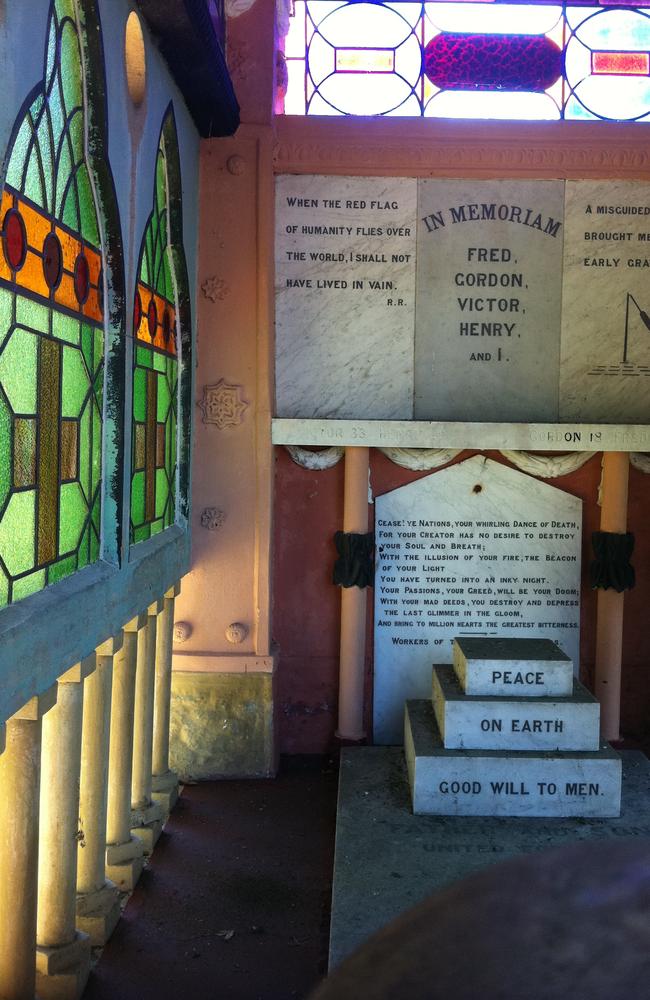The fantasist behind Toowong Cemetery's Temple of Peace
For Richard Ramo, the man behind a Brisbane cemetery's “temple of peace”, the truth never got in the way when it came to telling a really good story, writes Dot Whittington.
QLD News
Don't miss out on the headlines from QLD News. Followed categories will be added to My News.
Thousands jostled at the gates of Toowong Cemetery in December 1924, hoping to catch a glimpse of the coffin that would be placed in the new Temple of Peace, an elaborate mausoleum of plaster, marble and stained glass.
At the front step, a stone proclaimed, “all my hope lies buried here”.
It was a curiosity and its story and that of its creator is even more curious.
Richard Ramo, with some help from a local mason, had spent the previous nine months building the 3m high monument to his three sons killed in the Great War and his adopted son Ferdinand Christian “Fred” Borrell who had died just over a year earlier.
The ashes of two sons recovered from the World War I battlefields were placed in the temple and the dedication ceremony included the reinterment of Fred, who had been buried in the Church of England section of the cemetery.
Pup, his dog who had been “maliciously poisoned” was also memorialised inside.
Every year until 1939, Ramo, who described himself as a Socialist and an internationalist, placed a notice “in mournful memory” of his sons killed in 1915 – Victor at Messines in August, Gordon at Gallipoli in November, and Henry in Belgium in October – as well as Fred, who had died in Brisbane in November 1923.
Although Ramo’s messages and exhortations for peace are admirable, his personal story is much less poignant.

His real name was Richard Carl (or Karl) Paul Retzlaff and there is no record of his three sons going to the Great War.
An arrest warrant was issued in Redfern in 1907 for 11-year-old Gordon Retzlaff or Ramo, charged with being an uncontrollable child. Gordon Retzlaff enlisted under the Anglicised name of Gordon Redcliff and died on November 1, 1915 at Gallipoli.
There is no record of the birth, military service or death of Victor and Henry, although Ramo did have other two sons. Neither died in battle. Cecil enlisted as Cecil John Valentine Raymo and Percy Redcliff never signed up.
A son accused him of deserting the family in Sydney when the children were young, and he was also said to have been abusive to his wife Elise, who he committed to an asylum.
Ramo claimed that his father was a high-ranking Russian army officer who, becoming implicated in a political plot, was banished and took refuge in England where he married “a lady of birth and breeding”.
His father was assassinated, and Queen Victoria intervened for the widow, obtaining her a position in a Royal house in Germany. He was later also granted a position in the late Kaiser’s household.
After offending his imperial employer, Ramo said, he had been a wanderer on the face of the globe, eventually taking up his abode in Australia.
Karl Retzlaff aka Richard Ramo left Sydney in 1916 and opened a hairdressing salon and later a second-hand shop in Brisbane.
Young Fred Borrell “a good kind boy” came to work as his assistant in the salon in 1920-21. They “got on well” and Fred moved in with Ramo in September 1922, after which time Ramo adopted him as his son.
Fred’s mother said Fred was 27 years old, her son by a former marriage, and she had last seen him at Christmas 1922. She was not aware Ramo had adopted him.

In November 1923, Fred died from a gunshot injury, inflicted at close range, while at the back of his adopted father’s store in Roma Street. Although believed to be suicide, a court inquiry followed.
The inquiry heard that Fred had fallen in love with a married woman and that he had shot himself as the result of a love affair gone wrong.
Other witnesses said they “never thought that Borrell had it in him to shoot himself” and that Fred had been accused by his father of “having stolen deeds and of having broken crockery” and that they had quarrelled the evening before his death.
The inquiry closed on Wednesday, February 20, 1924 with no satisfactory conclusion.
In reference to Fred’s untimely death, Ramo inscribed inside the tomb: “A misguided love brought me to an early death.”
Whether it was the start of World War II or something else, Ramo, at 79, dropped out of the spotlight and his annual memorial notices stopped in 1939.
He died on July 13, 1951 aged 91 and his ashes added to the Temple of Peace. It is believed that at the time of his death, he was senile and had forgotten his association with the temple.
Read more in Grave Tales: Brisbane Vol 1 by Helen Goltz and Chris Adams, gravetales.com.au


